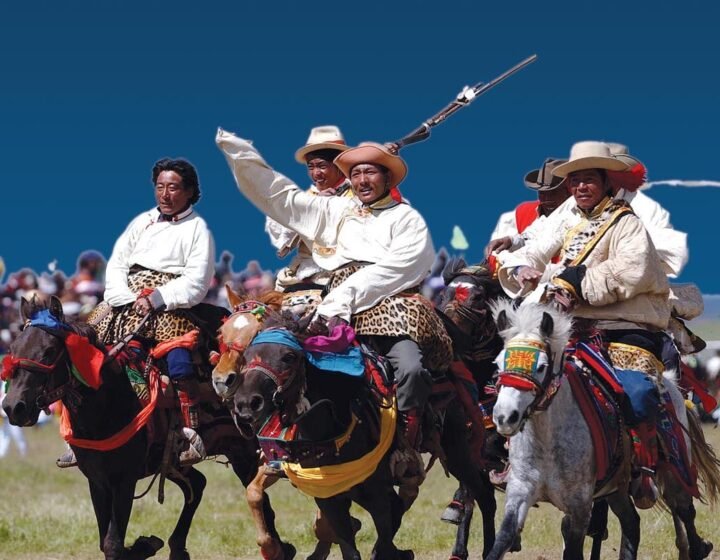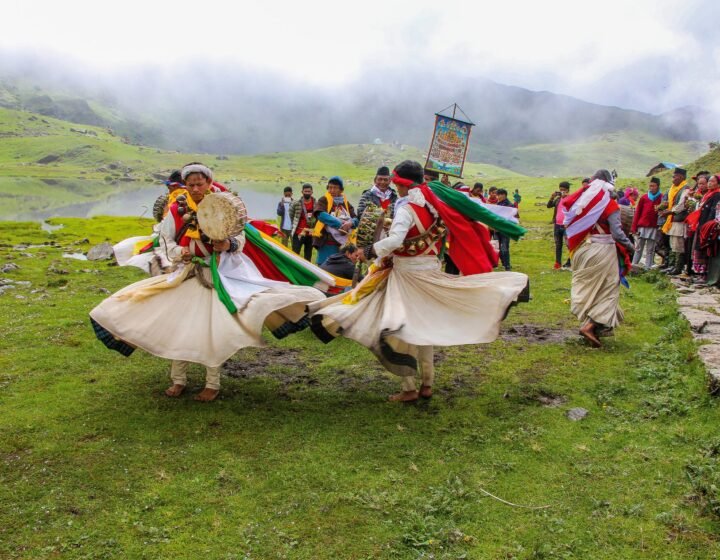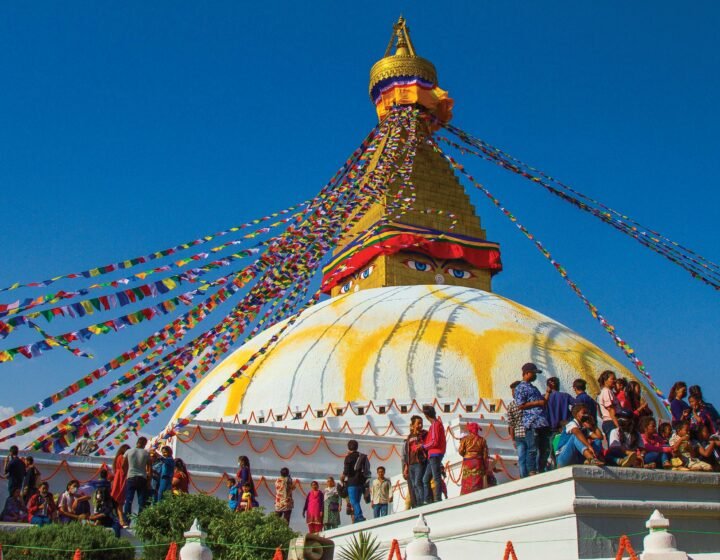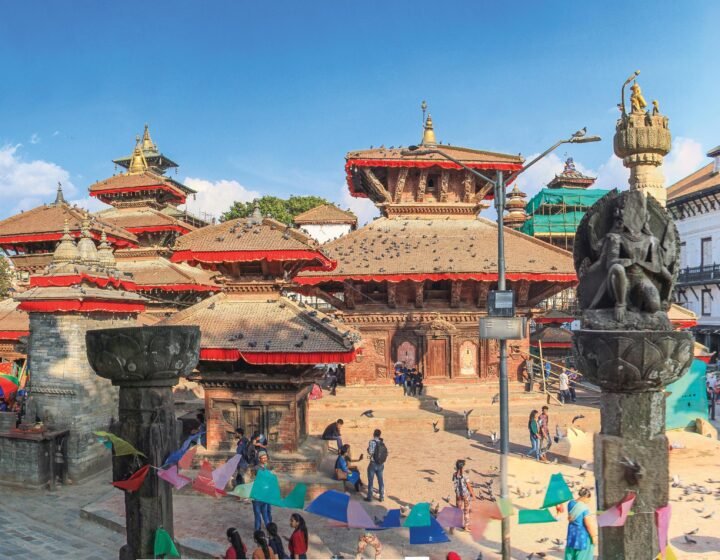
Nepal has 8 cultural heritage sites enlisted on UNESCO World Heritage List. Seven of these are located within the Kathmandu valley. In addition, there are many ancient towns, and settlements to visit. These places are full of cultural traditions, and festivals that are celebrated throughout the year.
Kathmandu Durbar Square
Kathmandu Durbar Square encompasses many temples and the Hanuman Dhoka Palace which translates as “the door of the monkey god”, a true devotee of Ram, and the seventh incarnation of Vishnu, the preserver of the Universe. According to the Hindu religion, the king was also considered an incarnation of Vishnu. It was the Royal Palace until 1934 when it was damaged by the great Nepal-Bihar earthquake. This former royal palace complex is endowed with shrines, monuments, and temples of different gods & goddesses. Another of the main attractions of Durbar Square is the abode of the Goddess Kumari, the only living goddess in the world.
Pashupatinath Temple
Pashupatinath Temple is one of the holiest Hindu temples in the world. It is dedicated to Lord Shiva. Ancient scriptures in the Vedas, Upanishads & Puranas have described him as the Lord of all living beings, and the source of eternal bliss & peace. It is recorded that it was rebuilt and provided with a golden roof by King Shiva Dev III around 1120AD. The temple is situated at the banks of the Bagmati River to the east of Kathmandu city. It is also home to the former royal cremation site. The most important festival is Maha Shivaratri, ‘The Great Night of Shiva’ during this festival over two hundred thousand pilgrimages visit the temple.
Swayambhunath
The huge Maha-chaitya is dedicated to Adi Buddha, the ‘Self-Created One, and is situated on a hillock just 3km west of Kathmandu city center. It is believed that the Stupa was built over the enormous thousand petal lotus with a blue flame on it. Swayambhu is one of the holiest sites for Buddhists. The view of the Kathmandu valley, the Himalayan range, and the sunrise from the stupa are amazing. Tourists call this temple a monkey temple since many monkeys call it home.
Boudhanath Stupa
Boudhanath is the biggest stupa in Nepal and is located 6km northeast of Kathmandu’s city center. It is one of the most important places of pilgrimage sites for Buddhists. In the past, when the trade routes to central, and western Tibet were fully open, traders, pilgrims, and travelers sought blessings at the stupa for safe passage over the mountain passes and gave thanksgiving to it upon arrival in Kathmandu. The stupa is believed to have been built in the 5th century AD by King Mandev. Every day, in the evening time the site becomes lively with hundreds of devotees walking around the stupa, many holding prayer wheels or counting prayer beads, and even some doing prostration.
Patan Durbar Square
Patan retains the most ancient air of all the valley’s three main cities, beginning with its reputation as the capital of the Kiranti dynasty. Another reason is the presents of the Ashoka stupas built in the four directions of the city in 250BC. The classic name of Patan is Lalitpur – the ‘City of Beauty.’ It is located 5km southeast of Kathmandu city across the Bagmati River. The Durbar square is full of ancient monuments, temples, and shrines, noted for their exquisite craftsmanship, and architectural beauty. While you are in Patan, the Golden Temple, Kumbheshwor Temple, and Mahaboudha Temple are worth visiting.
Bhaktapur Durbar Square
Bhaktapur means ‘the City of Devotees’, and is one of Nepal’s greatest treasures, renowned for its elegant art, fabulous culture, colorful festivals, traditional dances, and typical Newari lifestyle. The ancient city was built in the shape of a conch shell, a symbol associated with Lord Vishnu. It was once the capital of the entire valley and is situated 14km to the east of Kathmandu. Tourists visiting Nepal feel their visit is incomplete unless they get an enchanting glimpse of this ancient city of culture.
Changu Narayan Temple
Changu Narayan Temple is proven to be the oldest existing temple in Nepal. The two-tired temple is no doubt “a building that could stand alone to represent the very best in Nepalese art, and architecture.” The temple hosts the shrine of the Hindu god Lord Vishnu, the preserver of all the living beings of the world. It is located 6km north of Bhaktapur. A Licchavi King Mandev established a stone pillar there which dates back to 464 AD. The script found on the pillar is the oldest in Kathmandu valley.
Lumbini
Lumbini is the birth place of Lord Buddha. He was born in 623 BC,, and eventually crossed the riddle of the ocean of existence,, and showed the path of emancipation. He has become a symbol of peace, and compassion. Lumbini is situated 250 km southwest of Kathmandu in the plains of the Terai; the altitude is about 100 m above sea-level. Every year thousands of devotees from around the world come to Lumbini to pay homage to Lord Buddha. There are numerous Buddhist monuments established by devotees of different nations like Japan, Korea, China, Thailand,, and Burma etc. The current design of the Lumbini sacred garden is the brain child of renowned Japanese Architect Kenjo Tange.
Chitwan
Chitwan is an important national park listed as a UNESCO World Heritage Site in 1984. The area is about 932 sq km, and the elevation ranges from 110- 885m above sea-level. It is 150 km to the south west of Kathmandu; situated in the central part of Nepal. Chitwan is home to subtropical flora & fauna. The famous jungle safari activities are elephant rides, jungle drives, bird watching, canoe rides, local village tours etc. The main assets of the National park are the endangered tiger, the one-horned rhino, gharial crocodile, and 600 types of plants, 539 species of birds, 56 types of mammals, 47 kinds of reptiles, 126 sorts of fish, and 9 types of amphibians.
Pokhara
Pokhara is no doubt the most beautiful city of Nepal. It lies 200km to the west of Kathmandu valley. The average elevation is about 800m above sea level. It is situated in the lap of the giant Annapurna Himalayan Range. Pokhara is simply the best place to view the Annapurna Range which lies within the horizontal distance of 30km. Moreover, Dhaulagiri, Manaslu, and Ganesh Himal can be seen on a clear day. Pokhara is also known as Lake City of Nepal. The limestone caves, deep gorge of the Seti River, hot springs, and surrounding landscapes are just amazing. Paragliding, ultralight flights, zip flying, and boating are other interesting activities. Pokhara has been visited by many VIPs including former presidents of the USA Mr. Jimmy Carter, and Mr. Clinton,, and his Royal Highness Prince Charles, Mr. Hirohito etc.
Panauti
Panauti is a typical Newari town situated 32km to the south- east of Kathmandu valley. It is declared as a “Protected Monument Zone” under the Ancient Monument Preservation Act, 1956. One of the main festivals is the ‘Makar Mela’ which takes place once every 12 years for one month at the confluence of three holy rivers, two of which are visible with one an invisible mystical river as per legend. Thousands of devotees come to take a holy bath to be liberated from the sins committed during their life.
Nagarkot
Nagarkot is one of the famous hill resorts of Nepal. It is situated 32km to the north-east of Kathmandu at an altitude of 2175m. The main attraction is the panoramic view of the Himalayas. On a clear day one can witness some of the distant Khumbu peaks, Rolwaling, Dorje Lakpa, Langtang, Ganesh Himal, Manaslu, and the Annapurna range. Green valleys, colorful terraced fields, and a bird’s eye view of Kathmandu are other charms.
Gorkha
Gorkha is an historic town located 140km to the west of Kathmandu. This was a former capital of the great King Prithivi Narayan Shah who unified modern Nepal. The ancient royal palace, and temple of Goddess Kali is on the hillock at an altitude of 1525m. There are enchanting views of the Manaslu Range, Ganesh Himal, and Annapurna from here. Many brave Gurkha soldiers who fought both in I & II world war also come from this region.








